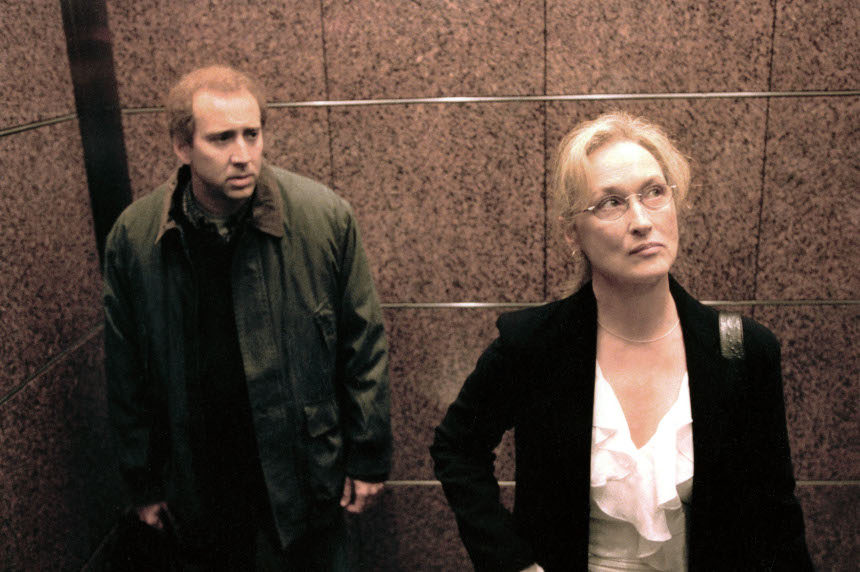When the film adaptation of Karl Alexander’s novel Time After Time arrived in theaters 40 years ago this week, it hit audiences with an original premise: what if H.G. Wells, the author of The Time Machine, had built one himself? The plot has Wells chase Jack the Ripper through time from 1890s London to 1970s San Francisco, commenting along the way on the differences in culture and offering a (fictional) explanation of how Wells might have arrived at some of his ideas.
That story is just one of many times that famous writers have made it into the movies. Sometimes their lives or adventures are entirely fictionalized. Other films give us rigidly researched dramas, broad comedies, or the what-just-happened mindtrip of Naked Lunch. Let’s look back on some of the most memorable transitions authors have made to screen.
Robert E. Howard and Novalyne Price Ellis in The Whole Wide World (1996)
The trailer for The Whole Wide World (Uploaded to YouTube by YouTube Movies)
Robert E. Howard is considered the father of the “sword and sorcery” subgenre of fantasy. He created Conan the Barbarian, Solomon Kane, Dark Agnes, Kull the Conqueror, and more. Through his writing for the pulps like Weird Tales, he became friends with H.P. Lovecraft and contributed to the horror master’s mythos stories. His relationship with schoolteacher and writer Novalyne Price Ellis became the subject of two of her books, notably One Who Walked Alone: Robert E. Howard, The Final Years. The Whole Wide World adapts that book, with Vincent D’Onofrio as Howard and Renee Zellweger as Ellis. Howard took his life at age 30 (an event depicted in the film), but his work lives on in prose and in Marvel Comics.
C.S. Lewis and Joy Davidman in Shadowlands (1993)
The trailer for Shadowlands (Uploaded to YouTube by YouTube Movies)
C.S. Lewis, most famous for The Chronicles of Narnia and The Screwtape Letters, stayed a bachelor until his late 50s, when he wed the writer/poet Joy Davidman. Initially, their marriage was made to keep Davidman, an American, in England, but it developed into something more when Davidman was diagnosed with cancer. She overcame it for a time, but unfortunately, it returned and she died in 1960. Lewis continued to raise her two sons from a previous marriage, one of whom, Douglas Gresham, became a producer on the Narnia films. Shadowlands recounts the story of the relationship, with Anthony Hopkins as Lewis and Debra Winger as Davidman. Curiously, in the movie, Davidman has only one son.
Dorothy Parker in Mrs. Parker and the Vicious Circle (1994)
A host of real-life writers and actors feature in Alan Rudolph’s 1994 Palme d’Or nominee, but the most important is the titular Mrs. Parker. Famed for her lacerating wit, Parker is played by Jennifer Jason Leigh. Leigh applied her usual caliber of scrupulous preparation for the role, reading all of Parker’s works and studying the two remaining audio recordings of the writer’s voice so that she could master Parker’s speaking style. The “Vicious Circle” of the title refers to an alternate name for the Algonquin Round Table, a group of critics, writers, and actors that met daily for lunch at the Algonquin Hotel in New York City from 1919 to around 1929.
Charlie Kaufman and Susan Orlean in Adaptation (2002)
The trailer for Adaptation (uploaded by Umbrella Entertainment)
Certainly the strangest entry on the list, the wild path that Adaptation takes began with screenwriter Charlie Kaufman (played by Nicolas Cage). Struggling with adapting Susan Orlean’s The Orchid Thief into a film, he radically altered the story, making the screenplay about himself trying to adapt the book. Along the way, he invented a twin brother for himself, devised a love affair between Orlean (Meryl Streep) and her book’s protagonist (Chris Cooper), and generally took it very far afield from reality. Director Spike Jonze was all in, and crafted a hybrid of comedy, drama, and thriller that drew enormous critical praise, four Academy Award nominations, and one win (Supporting Actor for Cooper).
Harvey Pekar in American Splendor (2003)
Harvey Pekar charted an unusual course to fame. While working as a Veterans Administration hospital clerk in Cleveland, Ohio, he created and the wrote the underground comic book series American Splendor. The stories, based on his own life and observations, drew national attention, which led to multiple appearances on Late Night with David Letterman. Pekar also wrote biographies and was well-known as an incisive music critic, with jazz as his specialty. The film is a unique hybrid of biography and documentary, including scenes where Paul Giamatti (playing Pekar) appears alongside the real Pekar. Some scenes use an animation style that features Pekar stepping in and out of the comic to reflect the autobiographical nature of his work. It was nominated for a number of awards and won several, including the Grand Jury Prize: Dramatic at Sundance and the National Society of Film Critics Award for Best Film.
William S. Burroughs in Naked Lunch (1991)
The trailer for Naked Lunch (Uploaded to YouTube by Recorded Picture Company)
David Cronenberg likes his movies . . . different. The Canadian director used his unique talents at generating unease through body-horror and unsettling visuals to bring Burroughs’s book to life. As Burroughs, Paul Weller appears in scenes inspired by both the book and the life of Burroughs himself. Sometimes, that verisimilitude is brutal, such as when the film stages a re-enactment of Burroughs’s accidental shooting of his wife and his drug use. Other parts are hallucinatory, involving imaginary creatures and the transformation of everyday objects like typewriters into monstrous insects. It’s not your conventional biopic in any way, shape, or form, but it is visually and structurally audacious.
Hunter S. Thompson in Fear and Loathing in Las Vegas (1998) and Where the Buffalo Roam (1980)
The trailer for Fear and Loathing in Las Vegas (Uploaded to YouTube by Movieclips)
Speaking of drugs, gonzo journalist Hunter S. Thompson’s life was full of insane adventures, a number of which were made possible by the miracle of modern chemistry. In fact, his exploits have been adapted into two films starring major talents: Fear and Loathing with Johnny Depp, and Buffalo with Bill Murray. Buffalo takes a bit more of a straightforward approach, while Fear and Loathing leans into the drug-fueled, propelled by director Terry Gilliam’s innovative visuals. Though neither commits a summation of Thompson’s work or personality to film, both movies led to an increase in interest for Thompson’s writing upon their respective releases.
Anne Perry in Heavenly Creatures (1994)
The trailer for Heavenly Creatures (uploaded by Movieclips Classic Trailers)
Anne Perry’s work typically deals in detective fiction of a historical variety. What wasn’t widely known until after the release of Peter Jackson’s 1994 film is that Perry herself had participated in a killing as a teenager that saw her incarcerated for five years. The movie tells that story as Pauline Parker (Melanie Lynskey) and Juliet Hulme (Kate Winslet, in her film debut), best friends with a rich fantasy life, decide to kill Parker’s mother when it appears that they’re going to be separated upon the divorce of Hulme’s parents. Parker and Hulme went to prison, and Hulme later adopted the name Anne Perry after her release. Perry has published 47 novels, two as recently as last year.
Many other films, good and bad, deal with writers in real and fictional circumstances. There’s the wartime tale of a young Ernest Hemmingway (In Love and War) and Phillip Seymour Hoffman’s indelible work as Truman Capote in Capote. There’s the risqué look at the lives of Henry Miller, his wife, June, and Anais Nin, Henry & June; the sexually charged narrative helped lead to the creation of the NC-17 film rating. Cameron Crowe fictionalized his own teen years working for Rolling Stone in Almost Famous, giving us a big dose of music critic Lester Bangs (Hoffman again) in the bargain. Just last year, Lee Israel’s story of writing and forgery made it to the screen.
They say that real writers never run out of stories; maybe the truth is that writers, and the rest of us, are stories, too.
Featured image: Nicolas Cage and Meryl Streep in “Adaptation”. Pictorial Press Ltd / Alamy Stock Photo.
Become a Saturday Evening Post member and enjoy unlimited access. Subscribe now



